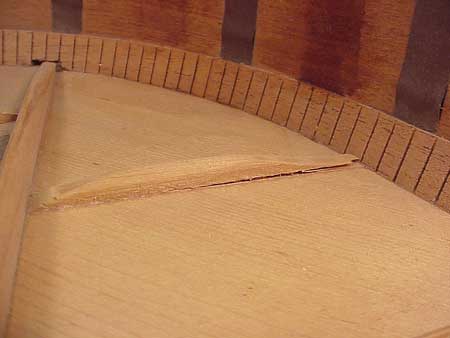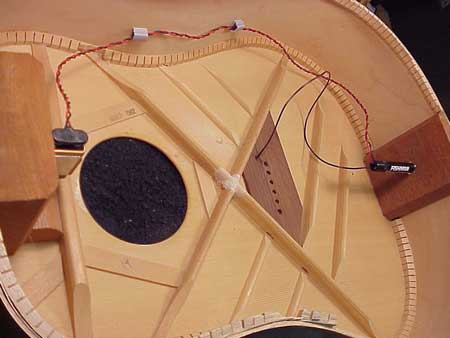These days, lots of guitars are made with their necks bolted to their bodies. On rare occasions, these bolts may be a bit loose, allowing the washers under them to make quite a lot of noise when the guitar is played.

As with many loose parts, simply tightening the bolts will make the problem go away.
By far the most active part of the guitar is its top. One of the more subtle top buzzes comes from an interesting loose part under the bridge. If a string is not properly seated and the windings snag between the bridge pin and the side of the hole, the string may hang down inside the guitar:

The string ball may be just a little loosely twisted on the end of the string, and may rattle and buzz on every note.
Some guitar bridges have lots of screws and adjustable parts:

Any of these parts can become loose and will rattle like crazy under the right circumstances.
Cracks, loose braces and other structural damage is frequently the cause of buzzing or rattling. A brace doesn't have to be as loose as this one to cause nasty sympathetic noises:

In fact, most "noisy" braces are ones in which the looseness is almost imperceptible. It can take a trained luthier quite a while to locate some of these nasty little fellows.
Clearly, loose braces and cracks should be repaired whether they buzz or not, but often it's the buzzing that alerts us to the presence of such damage.
Onboard electronics are increasingly part of the acoustic guitar. Adding a pickup means adding parts that can vibrate and make noises, especially if they become loose with age.
Considering how the wires hang around inside an acoustic guitar, it's amazing they don't rattle and buzz more often:

In fact, loose wires are not often the cause of internal rattles and buzzes. If wires do rattle, it's a simple matter to add little stick-on retainers to hold them in different positions to avoid rattles.
Electronic modules and controls, especially those with heavy batteries attached, are prone to rattling:

Often, these rattles can be stopped with little pieces of tape or strategically placed bits of plastic foam.
Loose parts are not the only causes of rattles and buzzes. Low action, uneven frets, trouble at the nut or saddle, improper truss rod adjustment and lots of other factors may cause buzzing. Loose parts may buzz all the time, or at certain notes only. If you suspect your guitar may have loose, rattling parts you can rap with your knuckles on various parts of the instrument, and you may get it to make the offensive noise without being played. If you can get it to rattle this way, you may well be able to locate the area where there's a loose bit. It may then be a simple matter to tighten the offending part. If that doesn't work local luthier should be able to go through a longer list of options and techniques to help you locate the tiniest little loose item.